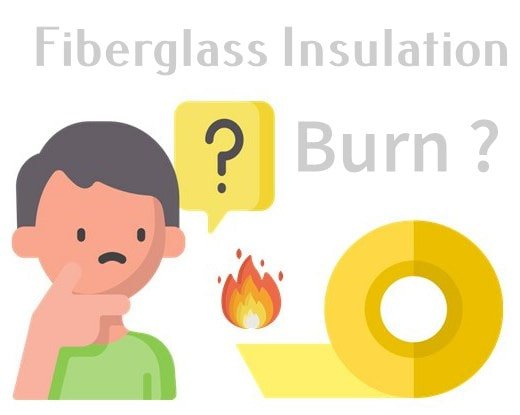Look for high R-values and safety while purchasing insulation. Flammability is a vital factor to consider. After all, no one wants to install flammable insulation. When fiberglass comes to mind for your insulation, you might have a question pop in your mind: ‘Will fiberglass insulation burn?’ Let’s take a closer look at this.
Fiberglass insulation products, manufactured from a combination of silica sand, limestone, and soda ash, are often used in homes due to their fire retardant properties. The glass is made from sand, and the limestone and soda ash lessen the melting temperature required to make it.
Borax and other substances such as feldspar, magnesite, and kaolin clay are used to improve the performance of the fiberglass.
The components must be heated once they have been blended. After that, to create a solid fiberglass, it needs to be heated to a temperature of 2,500°F. Glass can be turned into glass wool, filaments, or fibers once it has been molted.
Composition and Fire Resistance
Fiberglass insulation is made from tiny glass fibers spun from molten glass and woven into a dense mat. Because of its glass content, fiberglass insulation is naturally non-combustible. However, some fiberglass insulation products’ binders and facings (such as paper or foil) can be flammable.
Flammability of Fiberglass Insulation Components
| Component | Flammability |
|---|---|
| Glass Fibers | Non-combustible |
| Binding Materials | Varies (can be flammable) |
| Facing (Paper/Foil) | Flammable |
Will Fiberglass Insulation Burn?
The answer to the question, especially when considering fire safety measures during installation, is not a straightforward yes or no, as it is with many things in the building.
We’ll explain why fiberglass insulation can contribute to a house fire even though it does not burn and discuss how flammable an alternative to fiberglass insulation is.

Fiberglass insulation will not burn when safely installed but can melt at high temperatures. This highlights the importance of adhering to local building codes when installing fiberglass.
Brown paper, commonly used as a vapor barrier on batts, can catch fire, posing a fire hazard. Blown-in fiberglass insulation flammable concerns are minimal, as it is non-flammable but requires specialist equipment.
What Temperature Will Fiberglass Insulation Burn?
Even though fiberglass insulation will not burn easily, it can melt if heated to a high enough temperature. Fiberglass is supposed to melt at temperatures above 1,000 degrees Fahrenheit (540o Celsius).
Other insulation materials like cellulose and mineral wool can endure higher temperatures without melting. Vermiculite melts at 1,400 degrees Fahrenheit (760 degrees Celsius), while ceramic fiber and mineral wool will melt at 2,200 degrees Fahrenheit (1200 degrees Celsius).
If I Want to Throw Away My Old Insulation, Can I Burn It?
If you plan to dispose of old fiberglass insulation batts, remember that these materials, particularly those with craft paper or foil front, can contribute to an insulation fire.
Read also: Can You Burn Insulation?
Although the fiberglass will not burn, the paper and foil facings will. Fiberglass, particularly batt-type fiberglass, does not settle with age.
Is It Safe to Burn an Old Insulation?
Another thought you might have before burning fiberglass insulation is, ‘is it safe to burn insulation?’ You should be aware that burning old fiberglass insulation is quite poisonous and can burn very quickly depending on the amount of resin in the fiberglass.
Because it’s made of plastic strengthened with tiny glass fibers, smoldering fiberglass releases poisonous formaldehyde vapors and other harmful compounds, formaldehyde causes instant eye discomfort, headaches, and skin irritation, as well as the possibility of cardiac and respiratory mortality.
The Correct Way to Throw Away Your Old Insulation
If you have old insulation and need to throw it away immediately, burning it will just add another problem. All you need to do is wrap all your old insulation first. You may need contractor bags to carry such a huge load.
After that, you can contact your county’s waste management department or local garbage authority. The personnel there will point you toward the nearest specialist trash disposal facility, which is usually a construction-materials disposal facility.
In some situations, you may be required to pay a small fee to dispose of fiberglass insulation at the job site. You face a higher fee if you dispose of the insulation in your home’s garbage containers or dumpster.
Read also: How Long Does Fiberglass Insulation Last
Safety Measures and Recommendations
To enhance the fire safety of fiberglass insulation, consider the following recommendations:
- Use Faceless Insulation: Opt for fiberglass insulation without paper or foil facings to reduce the risk of flammability.
- Proper Installation: Ensure insulation is installed away from heat sources such as light fixtures, chimneys, and electrical wiring.
- Fire-Resistant Barriers: Use fire-resistant barriers or coatings over insulation to protect against potential ignition.
By following these guidelines, you can ensure that your fiberglass insulation provides thermal efficiency and safety in the event of a fire.
Practical Applications
In my professional experience overseeing numerous insulation projects, fire safety has always been a priority. For example, in a commercial building project, we opted for fiberglass insulation with a special fire-resistant face due to the building’s high occupancy and need for enhanced fire protection.
The insulation performed exceptionally well in safety inspections and fire drills, providing peace of mind for the building owners and occupants.
Conclusion
In conclusion, while fiberglass insulation does not burn due to its glass content, the flammability of binders and facings must be carefully considered. By leveraging expert knowledge and personal experience and adhering to recommended safety measures, you can effectively manage the fire risks associated with fiberglass insulation.


